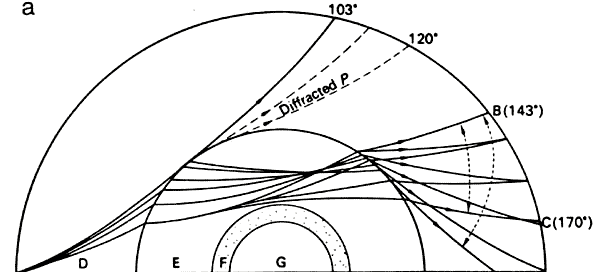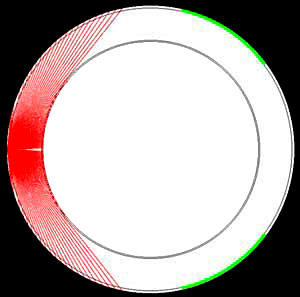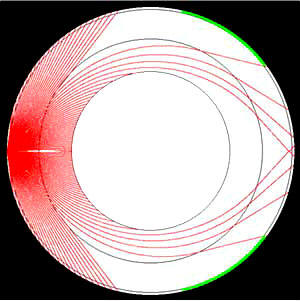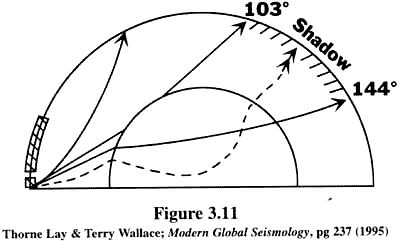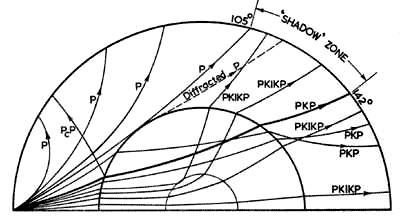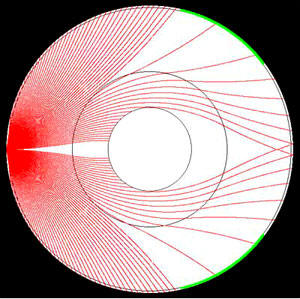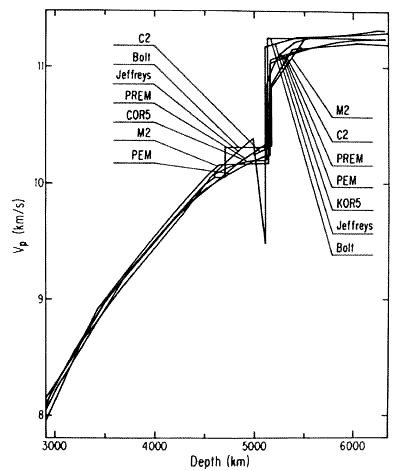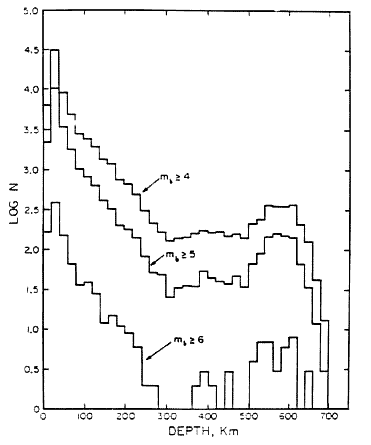|
Let me show you how my Hollow
Planet seismic model can explain the Earth's seismology better than the
existing solid Earth seismic model - and yet not one person at any
university has shown the slightest interest in this.
Lesson #1: The Earth is NOT a ball of molten lava.
The first question
everyone asks me when they hear of the Hollow Planet idea is: "Where does
lava come from then?" The (completely FALSE) impression schools have created
in everyone's minds is that the Earth is this red-hot ball of lava. They
then imagine that lava from volcanoes comes from the centre of the Earth.
Ask any geologist or seismologist if this is true and you will discover they
disagree. Standard geology and seismology texts tell a different story.
Scientists know that most lava is slightly radioactive and they believe it
is produced either by decaying radium (decayed uranium) or through stresses
in the crust. Lava is created by heat generated within the crust of the
Earth. The crust is said to be no more than 20 miles thick, although to be
honest nobody has ever actually penetrated the crust so we really do not
know what (if anything different) lies beneath it. Scientists will tell you
that lava is a crustal phenomenon and all lava comes from no deeper than 20
miles down.
In the above seismic diagram (from a text book on seismology), D=Mantle,
E=Outer core, G=Inner core. Lesson #2: Traditional Hollow Earth ideas fail the "seismology test". Let me show you why scientists simply laugh at the idea of a Hollow Planet. Keep in mind that all Hollow Earthers have, for more than a century, been saying that the Earth's crust is 800-1000 miles thick. Note in the above diagram, that seismic waves travel from the source of an earthquake (on the left) through the Earth at various angles and therefore reach the other side (this is not true of all seismic waves, but of the main ones, referred to as "P" waves). If you were to propose that a planet only has a crust of 1,000 miles or less, then this is why a scientist would laugh at you. See the image below.
In the above diagram you can see the seismic ray paths (red lines) moving
away from an earthquake source. Note how the huge cavity in this
"traditional" hollow earth model would block out all the "P"
waves from
reaching the other side of the Earth. So clearly, this type of approach does
not fit the known scientific facts and so we must discard it.
The obvious problem posed by the theory is that seismic
waves actually reach right across to the other side of the Earth. Scientists
are therefore quite confident that the P waves must have passed through the
core of the Earth and this tells them that there cannot be a cavity.
In the above model, I simply used the Earth's structure as scientists define
it now. I replaced the Outer Core with a cavity (I'll explain why later -
because there is a sound reason for it). But the thing I changed was the
structure of the Mantle. I wondered what would happen if density within a
sphere did not increase uniformly as has been assumed. What if density
actually DECREASES from a certain point onwards? You will notice all
solid-earth seismology shows ray paths curving in a "U" back to the surface
of the Earth. That is because density and pressure increases as you go
deeper. But if, for some reason, density were to suddenly decrease, then the
waves would curve in the opposite direction! I realized this, and you can
see what then happens. In the middle of the Mantle, where density suddenly
decreases, it causes seismic waves to travel around the cavity - right to
the other side of the Earth! The next problem in global seismology is explaining the mysterious "Shadow Zone". There is a lack of P waves between 103o-144o from the epicenter of a quake. Take a look at the problem as seen from a university-level text-book on seismology.
Note how the P waves strike the Outer Core and scientists believe the refraction caused by this sudden change in density can explain the shadow. But notice, in this university-level text book how they are befuddled because there are still some waves which reach the shadow zone (dotted line). They are at a complete loss to explain this. Now let me explain to you how perfectly my Hollow Earth model solves this problem. Take a look at the image below.
After changing some parameters in my
Hollow Planet seismic model, I have a
"Shadow Zone" which matches the facts exactly! I made the cavity smaller,
and I moved the "point of maximum density" (the dark circle in the Mantle)
somewhat lower. Note: The
Green area near the surface is the "Shadow Zone".
Now look at the amazing thing that happens. We have P waves behaving as
normal right up to 103o. Then suddenly there are very few of them inside the
Shadow Zone and then after the Shadow Zone we are a greater and greater
number of ray paths eventually converging on the other side of the Earth!
This is exactly consistent with the known facts of global seismology!
You have been wondering why I removed the
Outer Core altogether from my
Hollow Planet seismic model. The answer is simple. There are two kinds of
seismic waves - P waves - which are much like sound waves. They are pressure
waves caused by a direct "push" through the matter. But then there are
S
waves - shear waves - which are like taking a piece of hose-pipe and moving
it up and down rapidly. P waves can travel through everything
except a vacuum (although if they traveled through air they would be considerably
weaker than when they traveled through rock or a liquid). S waves however,
can only be transmitted through rigid materials - like rock. It has long
been known to scientists that unlike P waves which can travel around the
world - S waves are in fact "blocked" by something. They named this
"something" the Outer Core. They decided the
Outer Core had to be non-rigid.
If the Outer Core were a type of "liquid" then
P waves could pass through
it, but S waves could not. Hence they "invented" the
Outer Core. Very early
on, when I became interested in the Hollow Earth idea, I
realized this
property of the Outer Core, and I wondered if the Outer
Core was really a
liquid, or if it was, in reality a cavity. My big problem however was
figuring out how P waves behaved.
The waves we are interested in are those which passed
through the core - the
PKP and PKIKP waves. When one takes a look at the data showing the speed
with which seismic waves travel, one discovers an interesting thing: Waves
which pass through the Core (those which are supposed to be going in a
straight line) actually slow down! What makes this even more curious is that
P waves are supposed to speed up when they pass through dense material. And
there is no place on this planet which is as dense as the Inner Core! So why
do P waves then slow down? According to the formula for the transmission of
sound/pressure waves - speed is affected by two factors: (a) Density (b)
Elasticity. This gives scientists a way of getting out of the problem by
saying: "If the Density has increased, but the wave has slowed down, it must
THEREFORE mean that the Elasticity increased."
Take a look at the ray paths of the waves which reached the other side of the Earth, beyond the Shadow Zones. Look at the paths they traveled.
Both those factors would cause the waves to
take a longer time to travel to the other side of the Earth, hence, giving
the appearance that they slowed down, while apparently traveling in a
more-or-less straight line!! There, once more, we find a perfect match
between my Hollow Planets Seismic model and what we know about global
seismology. As you can see, this explanation accounts for everything
observed and yet there is no need for either an Outer or
Inner Core. Seismologists often produce diagrams such as the one below which show the speed of seismic waves inside the Earth at various depths.
You will notice, at various depths, such as at the 5,000 Km level, the speed
of waves changing very sharply - either speeding up or slowing down.
Scientists look at these sharp changes in speed and then state that this is
due to sharp changes in density. They use this to "prove" that the
Mantle is
composed of a different type of material to the Outer Core and so forth. You
have seen the Hollow Planets seismic model and how radically a seismic ray's
path may differ from the solid Earth model. Supposing the Earth really is
hollow, it would then follow that the paths of waves differ in reality from
what scientific theory supposes. That being the case, scientists may suppose
a certain ray speeds up or slows down when in fact it does nothing of the
kind. If they knew the right path (like the rays going through the core for
example), then it might turn out that such rapid speed changes never
actually occur.
According to
scientists, pressure increases with depth. According to their calculations
the pressure is so great that between 70-150 Km down, all rock will begin to
flow. Below 150 Km there is no known material which will not flow.
Therefore, according to scientists, there can be no earthquakes with
epicenters deeper than 150 Km - because it is IMPOSSIBLE!
It shows that earthquakes
occur right up to a depth of 300 Km down. The
picture is somewhat consistent with science's expectations because there are
less quakes with depth (though they do not stop at 150 Km as expected). Then
a most curious thing happens, they increase in number up to a depth of 700
Km where they end. Scientists try to explain these quakes by invoking
various possible strange properties of matter. Although each theory advanced
so far has had problems with it.
There is "rule" in science known as
Occam's razor.
Occam's Razor is a little piece of logic which states: When choosing between
two or more theories it is most likely that the simplest explanation is the
correct one. You have now seen my simple "sandwich" Hollow Planet model,
which assumes the Earth is largely homogenous in composition, and you have
seen how this simple model can match and even better the achievements of the
more complex and unwieldy solid-Earth model. Does this idea of mine not
satisfy Occam's Razor much more than the solid-Earth theory does?
|
